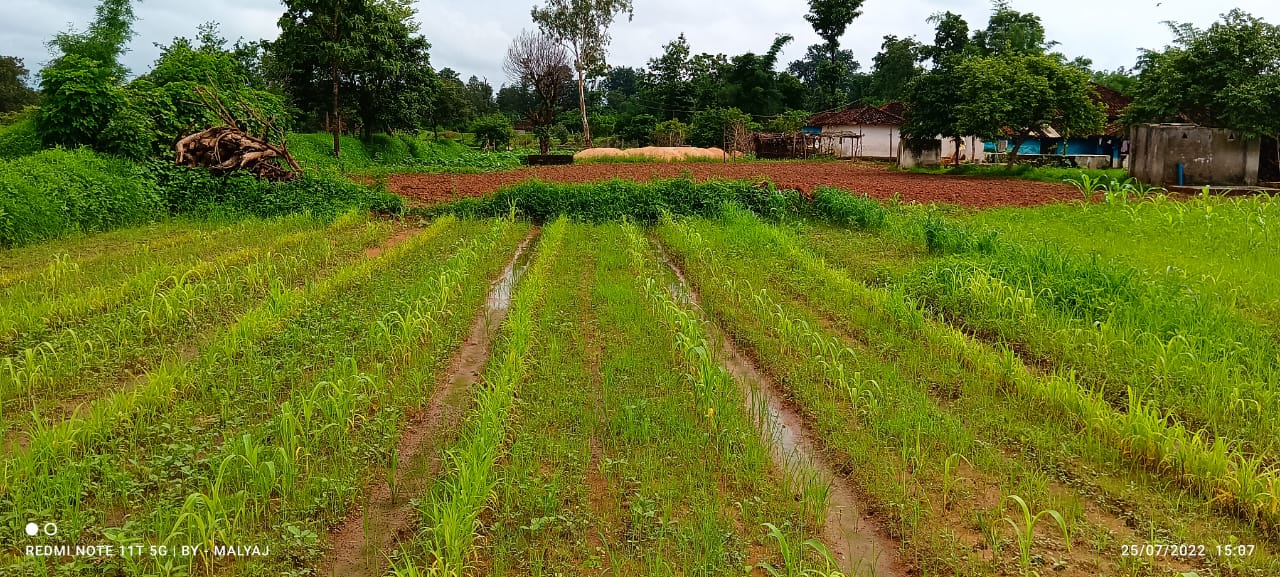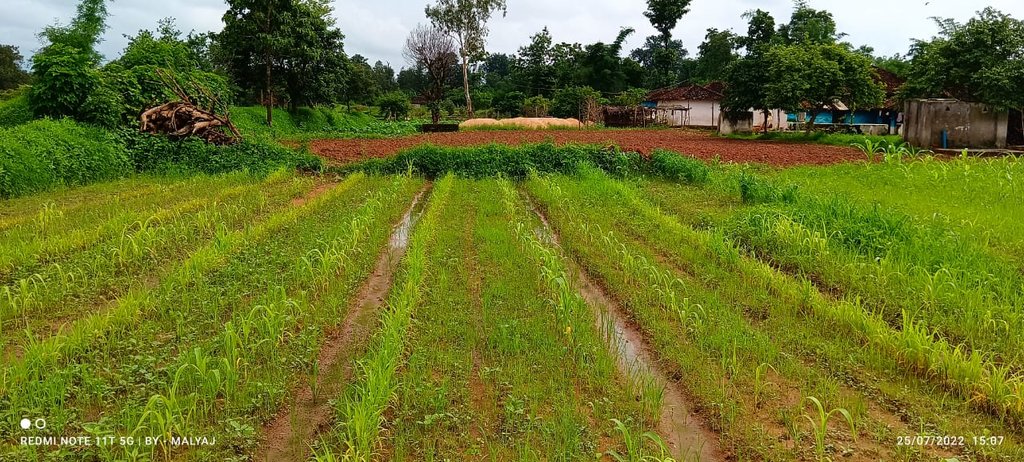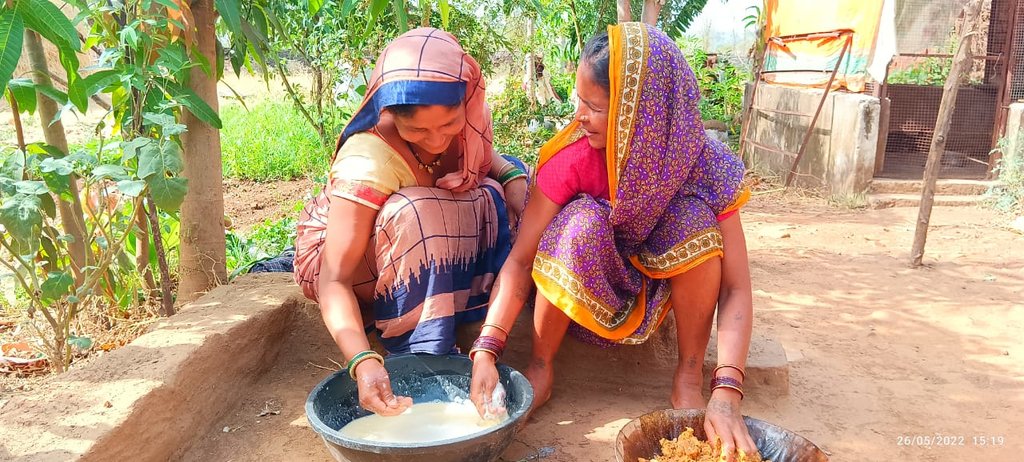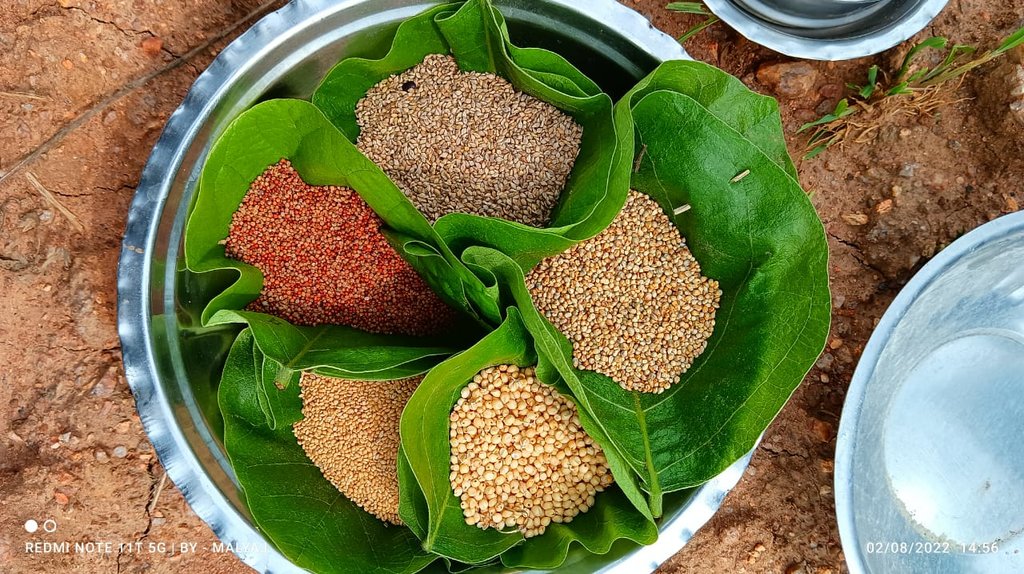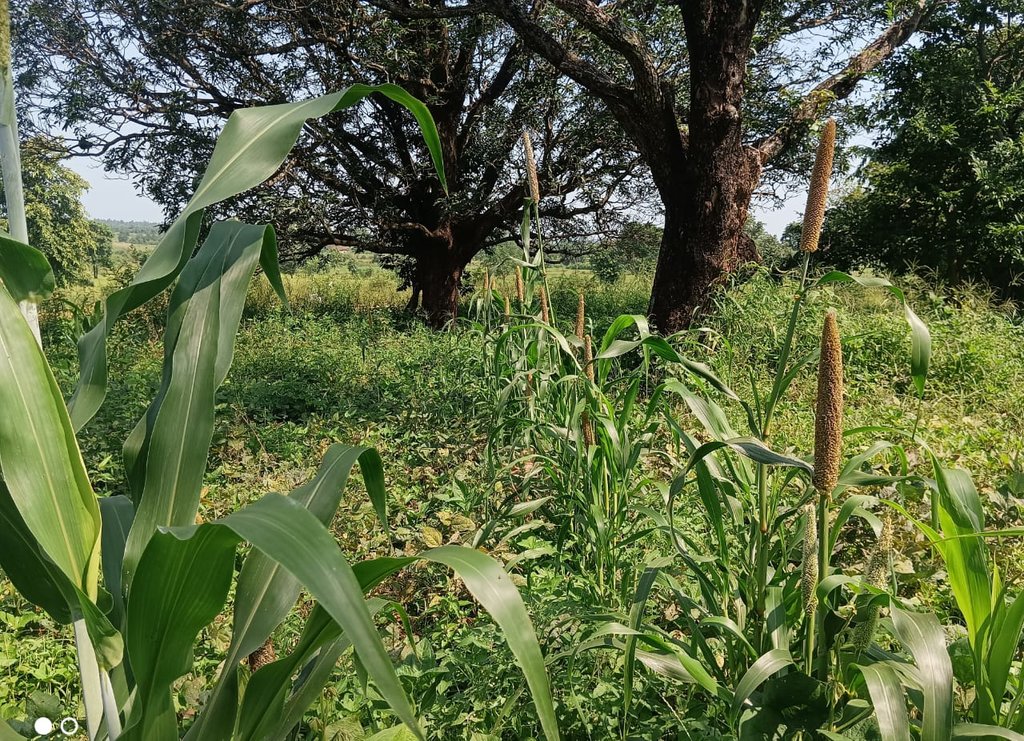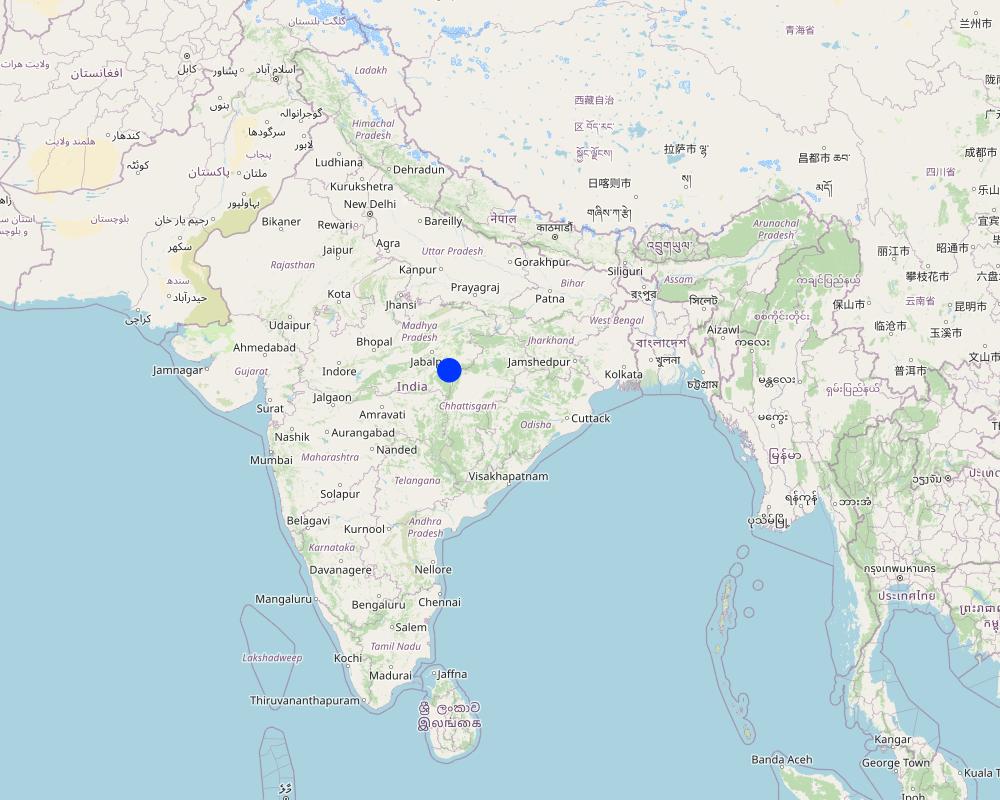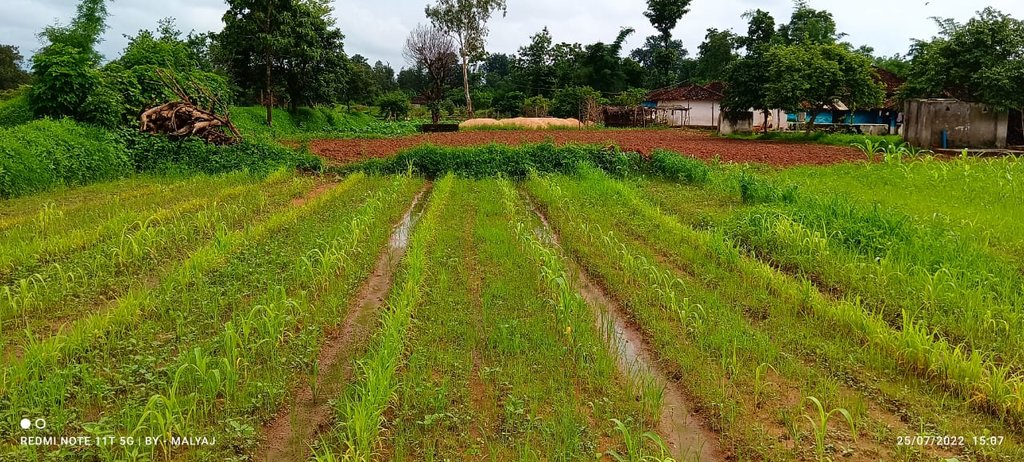Pre-Monsoon Dry Sowing (PMDS) [Índia]
- Criação:
- Atualização:
- Compilador/a: Santosh Gupta
- Editores: Noel Templer, Stephanie Katsir, Kim Arora, Tabitha Nekesa, Ahmadou Gaye, Siagbé Golli
- Revisores: Udo Höggel, Sally Bunning
technologies_6697 - Índia
Veja as seções
Expandir tudo Recolher tudo1. Informação geral
1.2 Detalhes do contato das pessoas capacitadas e instituições envolvidas na avaliação e documentação da tecnologia
Nome do projeto que facilitou a documentação/avaliação da Tecnologia (se relevante)
Soil protection and rehabilitation for food security (ProSo(i)l)Nome da(s) instituição(ões) que facilitou(ram) a documentação/ avaliação da Tecnologia (se relevante)
Deutsche Gesellschaft für Internationale Zusammenarbeit - India (GIZ India) - ÍndiaNome da(s) instituição(ões) que facilitou(ram) a documentação/ avaliação da Tecnologia (se relevante)
CIAT International Center for Tropical Agriculture (CIAT International Center for Tropical Agriculture) - QuêniaNome da(s) instituição(ões) que facilitou(ram) a documentação/ avaliação da Tecnologia (se relevante)
Ecociate Consultants (Ecociate Consultants) - Índia1.3 Condições em relação ao uso da informação documentada através de WOCAT
O compilador e a(s) pessoa(s) capacitada(s) aceitam as condições relativas ao uso de dados documentados através do WOCAT:
Sim
1.4 Declaração de sustentabilidade da tecnologia descrita
A tecnologia descrita aqui é problemática em relação a degradação da terra de forma que não pode ser declarada uma tecnologia de gestão sustentável de terra?
Não
Comentários:
The technology described here is related to sustainable land and other resource management systems.
2. Descrição da tecnologia de GST
2.1 Descrição curta da tecnologia
Definição da tecnologia:
The Pre-Monsoon Dry Sowing Technology aims to sow 12 to 15 different crop varieties in April without waiting for rain. To achieve this the seeds are pelletized with a mixture of clay soils, bio-inoculants like dried Ghanjeevamruth and Dravajeevamrit, and ash. The main objective of this technology is to empower rainfed farmers by utilizing the initial rainfall in April and May for crop cultivation. By using pelettized seeds, they can maximize the effectiveness of rainfall showers before the arrival of the monsoon season. Such seeds can also survive, if there are delay in the rainfall as the pellets around the seed help it in maintaining the moisture.
2.2 Descrição detalhada da tecnologia
Descrição:
Pre-monsoon dry sowing (PMDS) is a system of sowing, tilling and tending the land wherein the farmer grows crops in non-farming seasons or whenever there is no crop cover on the land. This can be practised before the advent of monsoon, during summer (April-May), after Kharif and before the beginning of the Rabi season (September and October). PMDS harnesses the water vapor from air that gets settled in the form of early morning dew. The dew supplies the required moisture to the soil. (Reference:-https://apcnf.in/wp-content/uploads/2022/05/IDS-2020-2021-APCNF-PMDS-Report.pdf)
In the study where PMDS was practised before the onset of the monsoon season, typically during the dry month of April. The seeds are pelletized with a mixture of clay soils, bio-inoculants, and ash, which creates a protective coating around the seed and helps it to germinate even in the case of delayed rains or very little rainfall. The coating around the seed, helps it to maintain moisture and support its germination. As the name suggests, the technology is good for utilising the pre-monsoon season by advancing the sowing cycles, using the usually dry months of summer and utilising the pre-monsoon rains.
This technology benefits rainfed areas where farmers rely solely on rainfall for irrigation. PMDS aims to promote an extended duration of crop cover under rainfed conditions, allowing farmers to cultivate crops with a reduced risk of crop failure in the cases of delayed or lower rainfall. Since seeds are germinated before the arrival of monsoon, there are times when they can also survive the heavy rains. This technology is useful in utilising moisture to the best extent possible as seeds are covered with the outer layer of clay and other stuff. In the Mandla District of Madhya Pradesh, farmers utilized seeds from their homes, comprising 12 to 15 crops, including cereals, pulses, and spices. These collected seeds were pelletized, dried for 24 hours, and broadcasted into minimally tilled soil. The diversified crop combination was grown until July and mixed with the soil before paddy transplanting. This process improves the soil's microbial activity, resulting in increased yields in crops grown before paddy and in the paddy crop itself. Therefore, the farmers benefit from increased production and yields through this technique of PMDS.
PMDS not only improves the economics of farmers but it also improves soil health. The covering of the soil with different crops protects it from heat, pounding rain, and wind. It also improves diversity in soil microorganisms, beneficial insects and other species. Covering soil for 365 days with plant diversity is also critical to protect soil health and balance climate change. PMDS can facilitate all these functions.
2.3 Fotos da tecnologia
2.5 País/região/locais onde a tecnologia foi aplicada e que estão cobertos nesta avaliação
País:
Índia
Região/Estado/Província:
Madhya Pradesh
Especificação adicional de localização:
Bichhiya block
Especifique a difusão da tecnologia:
- Aplicado em pontos específicos/concentrado numa pequena área
O(s) local(is) tecnológico(s) está(ão) localizado(s) em uma área permanentemente protegida?
Não
Comentários:
The technology is applied by rainfed farmers in the Mandla District of Madhya Pradesh.
Map
×2.6 Data da implementação
Indique o ano de implementação:
2022
2.7 Introdução da tecnologia
Especifique como a tecnologia foi introduzida:
- durante experiências/ pesquisa
- através de projetos/intervenções externas
Comentários (tipos de projeto, etc.):
The modified PMDS technology used in another program, the Andhra Pradesh Natural Farming Program, has been adopted here.
3. Classificação da tecnologia de GST
3.1 Principal/principais finalidade(s) da tecnologia
- Melhora a produção
- Reduz, previne, recupera a degradação do solo
- Preservar/melhorar a biodiversidade
- Adaptar a mudanças climáticas/extremos e seus impactos
- Criar impacto econômico benéfico
3.2 Tipo(s) atualizado(s) de uso da terra onde a tecnologia foi aplicada
Uso do solo misturado dentro da mesma unidade de terra:
Não

Terra de cultivo
- Cultura anual
Cultivo anual - Especificar culturas:
- cereais - arroz (zona húmida)
Número de estações de cultivo por ano:
- 1
Especifique:
Generally, Paddy is transplanted in July Month in the Mandla District and harvested around November. This region is majorly rainfed, and only 9% of the area has some irrigation source.
O cultivo entre culturas é praticado?
Não
O rodízio de culturas é praticado?
Não
3.3 O uso do solo mudou devido à implementação da Tecnologia?
O uso do solo mudou devido à implementação da Tecnologia?
- Sim (Por favor, preencha as perguntas abaixo com relação ao uso do solo antes da implementação da Tecnologia)
Uso do solo misturado dentro da mesma unidade de terra:
Não

Terra de cultivo
- Cultura anual
Cultivo anual - Especificar culturas:
- cereais - milho
- cereais - sorgo
- leguminosas e pulses - lentilhas
- Lentils include - Black gram, Cowpea, Green Gram, Red Gram and Oil seeds including sesame and Coriander.
O cultivo entre culturas é praticado?
Sim
Em caso afirmativo, especifique quais são as culturas intercultivadas:
The above mention crops are generally mixed together and grown on the same patches of land in April.
O rodízio de culturas é praticado?
Não
Comentários:
The PMDS technology has enabled crop diversification in the Mandla District from April to July.
3.4 Abastecimento de água
Abastecimento de água para a terra na qual a tecnologia é aplicada:
- Precipitação natural
3.5 Grupo de GST ao qual pertence a tecnologia
- Solo/cobertura vegetal melhorada
- Perturbação mínima ao solo
- Gestão integrada de fertilidade do solo
3.6 Medidas de GST contendo a tecnologia

Medidas agronômicas
- A1: cobertura vegetal/do solo
- A2: Matéria orgânica/fertilidade do solo
- A6: Gerenciamento de resíduos
A6: Especificar o gerenciamento de resíduos:
A 6.4: retido

Medidas de gestão
- M1: Mudança no tipo de uso da terra
- M2: Mudança de gestão/nível de intensidade
Comentários:
The PMDS (pre-monsoon dry sowing) technique involves crop diversification and the utilization of rainfed land from April to July, typically left unused, to improve soil health. This is achieved by planting green crops that are later harvested, leaving the crop biomass in the soil to retain moisture, and subsequently growing paddy crops on the same land. This approach has the added benefit of increasing yields, improving crop quality, and reducing farmers' reliance on only one single crop.
3.7 Principais tipos de degradação da terra abordados pela tecnologia

Erosão do solo pela água
- Wt: Perda do solo superficial/erosão de superfície

Deteriorização física do solo
- Pc: Compactação
- Pu: perda da função bioprodutiva devido a outras atividades

Degradação biológica
- Bc: redução da cobertura vegetal
Comentários:
Mandla district receives rainfall of around 1500mm, and soil is highly susceptible to erosion. Covering the soil with different crops reduces the erosion potential, and mixing the soil with biomass improves soil health.
3.8 Redução, prevenção ou recuperação da degradação do solo
Especifique o objetivo da tecnologia em relação a degradação da terra:
- Prevenir degradação do solo
- Reduzir a degradação do solo
Comentários:
Land degradation by water erosion is reduced by covering the topsoil with crops for an extended duration. The addition of crop biomass improves soil health.
4. Especificações técnicas, implementação de atividades, entradas e custos
4.1 Desenho técnico da tecnologia
Especificações técnicas (relacionada ao desenho técnico):
PMDS was undertaken at various sizes of plots based on the availability of land with farmers. Some farmers did at 0.10 acres of land while others did at 2 acres. Also, there was no fixed pattern that was followed for the quantity and variety of seeds. Whatever seeds were available were sown. In the image above, it can be seen that the field where PMDS was undertaken has multiple crops at different stages of their growth while the area with no PMDS has no crop and fallow red soil can be seen.
Autor:
Santosh
Data:
22/02/2023
4.2 Informação geral em relação ao cálculo de entradas e custos
Especifique como custos e entradas foram calculados:
- por área de tecnologia
Indique o tamanho e a unidade de área:
1 acre
Outro/moeda nacional (especifique):
INR (March, 2023)
Se for relevante, indique a taxa de câmbio do USD para moeda local (por exemplo, 1 USD = 79,9 Real): 1 USD =:
82,5
Indique a média salarial da mão-de-obra contratada por dia:
204 INR
4.3 Atividades de implantação
Comentários:
There are no establishment activities under the PMDS.
4.4 Custos e entradas necessárias para a implantação
Comentários:
There are no establishment costs required for PMDS as it's only a sowing activity. Farmers do hire agriculture equipments to undertake the activity.
4.5 Atividades recorrentes/manutenção
| Atividade | Periodicidade/frequência | |
|---|---|---|
| 1. | Collection of seeds | 1 month before the onset of Monsoon (mid May in project area) |
| 2. | Seed treatment and preparation of seed balls | End of May in project area |
| 3. | Broadcasting of the seed balls | End of May in project area |
| 4. | Soil rotation | 2-3 days after the broadcasting of seed balls |
| 5. | Harvesting of leafy vegetables, fodder and other produces | Mid of June to mid of July |
| 6. | Mixing the green manure in soils | End of July or before transplantation of rice |
4.6 Custos e entradas necessárias pata a manutenção/atividades recorrentes (por ano)
| Especifique a entrada | Unidade | Quantidade | Custos por unidade | Custos totais por entrada | % dos custos arcados pelos usuários da terra | |
|---|---|---|---|---|---|---|
| Mão-de-obra | Seed treatment, preparation of seed balls | Person days | 1,0 | 200,0 | 200,0 | 100,0 |
| Mão-de-obra | Broadcasting of seeds | Person days | 1,0 | 200,0 | 200,0 | 100,0 |
| Mão-de-obra | Harvesting of the crops | Person days | 2,0 | 150,0 | 300,0 | 100,0 |
| Equipamento | Agriculture equipment for soil rotation | Hour | 0,5 | 600,0 | 300,0 | 100,0 |
| Equipamento | Cultivator | Hour | 1,0 | 600,0 | 600,0 | 100,0 |
| Material vegetal | Seeds of different crops | kg | 6,0 | 75,0 | 450,0 | 100,0 |
| Fertilizantes e biocidas | Bio-inputs | LS | 1,0 | 400,0 | 400,0 | 100,0 |
| Custos totais para a manutenção da tecnologia | 2450,0 | |||||
| Custos totais de manutenção da Tecnologia em USD | 29,7 | |||||
Comentários:
Technical inputs were provided from the project around the seed treatment, sowing, and monitoring of the crops.
4.7 Fatores mais importantes que afetam os custos
Descreva os fatores mais determinantes que afetam os custos:
Availability of seeds, bio-inputs, and rainfall pattern. Usually, there are rains during the pre-monsoon season in the project area, however, in case of no rains at all during the entire summer, farmers may not be in a position to achieve the desired results.
5. Ambiente natural e humano
5.1 Clima
Precipitação pluviométrica anual
- <250 mm
- 251-500 mm
- 501-750 mm
- 751-1.000 mm
- 1.001-1.500 mm
- 1.501-2.000 mm
- 2.001-3.000 mm
- 3.001-4.000 mm
- > 4.000 mm
Especifique a média pluviométrica anual em mm (se conhecida):
1427,00
Especificações/comentários sobre a pluviosidade:
Monsoon season is from June-September, which has the majority of the rainfall.
Indique o nome da estação meteorológica de referência considerada:
District at glance report of Ministry of Water Resources, Central Groundwater Board, North Central Region BHOPAL, 2013
Zona agroclimática
- Subúmido
- Semiárido
The National Bureau of Soil Survey & Land Use Planning (NBSS&LUP) developed twenty agroecological zones based on the growing period as an integrated criterion of adequate rainfall, and soil groups. It delineated boundaries adjusted to district boundaries with a minimal number of regions. Mandla District of Madhya Pradesh lies in a Hot subhumid ecoregion with red and black soil. Precepitation - 1000–1500mm; Potential evapotranspiration -1300–1500 mm; Length of growing period-150–180days.
5.2 Topografia
Declividade média:
- Plano (0-2%)
- Suave ondulado (3-5%)
- Ondulado (6-10%)
- Moderadamente ondulado (11-15%)
- Forte ondulado (16-30%)
- Montanhoso (31-60%)
- Escarpado (>60%)
Formas de relevo:
- Planalto/planície
- Cumes
- Encosta de serra
- Encosta de morro
- Sopés
- Fundos de vale
Zona de altitude:
- 0-100 m s.n.m.
- 101-500 m s.n.m.
- 501-1.000 m s.n.m.
- 1.001-1.500 m s.n.m.
- 1.501-2.000 m s.n.m.
- 2.001-2.500 m s.n.m.
- 2.501-3.000 m s.n.m.
- 3.001-4.000 m s.n.m.
- > 4.000 m s.n.m.
Indique se a tecnologia é aplicada especificamente em:
- Não relevante
Comentários e outras especificações sobre a topografia:
Bichhiya is a block in the Mandla district characterized by diverse topography. The block is located in the southern part of the District and is situated in the foothills of the Satpura range.
The topography of the Bichhiya block is hilly. The block has an average elevation of around 550 meters above sea level. The hills are covered with forests and are rich in flora and fauna.
The region has several small streams and tributaries that flow through it, which are mostly seasonal and originate in the hills.
5.3 Solos
Profundidade do solo em média:
- Muito raso (0-20 cm)
- Raso (21-50 cm)
- Moderadamente profundo (51-80 cm)
- Profundo (81-120 cm)
- Muito profundo (>120 cm)
Textura do solo (solo superficial):
- Grosso/fino (arenoso)
Textura do solo (>20 cm abaixo da superfície):
- Médio (limoso, siltoso)
Matéria orgânica do solo superficial:
- Baixo (<1%)
5.4 Disponibilidade e qualidade de água
Lençol freático:
5-50 m
Disponibilidade de água de superfície:
Médio
Qualidade da água (não tratada):
Água potável precária (tratamento necessário)
A qualidade da água refere-se a:
tanto de águas subterrâneas quanto de superfície
A salinidade da água é um problema?
Não
Ocorre inundação da área?
Não
Comentários e outras especificações sobre a qualidade e a quantidade da água:
The region has several small streams and tributaries that flow through it, primarily seasonal and originating in the hills. The area is also known for its waterfalls, including the Patalpani waterfall, a popular tourist destination.
5.5 Biodiversidade
Diversidade de espécies:
- Alto
Diversidade de habitat:
- Alto
Comentários e outras especificações sobre biodiversidade:
The area is surrounded by Kasha National Park and Phen Wildlife Sanctuary, with a good presence of forest area. Thus biodiversity is outstanding.
5.6 Características dos usuários da terra que utilizam a tecnologia
Sedentário ou nômade:
- Sedentário
Orientação de mercado do sistema de produção:
- misto (subsistência/comercial)
Rendimento não agrícola:
- >50% de toda renda
Nível relativo de riqueza:
- Pobre
Indivíduos ou grupos:
- Indivíduo/unidade familiar
Nível de mecanização:
- Trabalho manual
- Tração animal
Gênero:
- Mulheres
- Homens
Idade dos usuários da terra:
- Jovens
- meia-idade
Indique outras características relevantes dos usuários da terra:
Bichhiya block has a significant tribal population. According to the 2011 Census of India, the block has a total population of around 47,000, of which approximately 41% are classified as Scheduled Tribes (STs). The powerful tribes inhabiting the region include the Gonds, Baigas, and Korkus.
5.7 Área média de terrenos utilizados pelos usuários de terrenos que aplicam a Tecnologia
- < 0,5 ha
- 0,5-1 ha
- 1-2 ha
- 2-5 ha
- 5-15 ha
- 15-50 ha
- 50-100 ha
- 100-500 ha
- 500-1.000 ha
- 1.000-10.000 ha
- > 10.000 ha
É considerado pequena, média ou grande escala (referente ao contexto local)?
- Pequena escala
5.8 Propriedade de terra, direitos de uso da terra e de uso da água
Propriedade da terra:
- Indivíduo, intitulado
Direitos do uso da terra:
- Indivíduo
Direitos do uso da água:
- Comunitário (organizado)
- Indivíduo
Os direitos de uso da terra são baseados em um sistema jurídico tradicional?
Sim
5.9 Acesso a serviços e infraestrutura
Saúde:
- Pobre
- Moderado
- Bom
Educação:
- Pobre
- Moderado
- Bom
Assistência técnica:
- Pobre
- Moderado
- Bom
Emprego (p. ex. não agrícola):
- Pobre
- Moderado
- Bom
Mercados:
- Pobre
- Moderado
- Bom
Energia:
- Pobre
- Moderado
- Bom
Vias e transporte:
- Pobre
- Moderado
- Bom
Água potável e saneamento:
- Pobre
- Moderado
- Bom
Serviços financeiros:
- Pobre
- Moderado
- Bom
6. Impactos e declarações finais
6.1 Impactos no local mostrados pela tecnologia
Impactos socioeconômicos
Produção
Produção agrícola
Comentários/especificar:
Based on the discussion with land users and implanting agency, production of the main crop (Paddy) increased by 20-25%. (The crop combination under PMDS has some nitrogen-fixing crops and the crop biomass improves the nutrient availability for the next crop which is paddy, also the better moisture helped the improvement in productivity of paddy crop as well.). Additional production from crops sown in April month was generated. An impact assessment study to document the quantifiable results has not been conducted so far.
Risco de falha de produção
Comentários/especificar:
Risk of of production failure reduced due to crop diversification
Diversidade de produtos
Comentários/especificar:
Crop diversification by sowing multi crops of cereals, millets, pulses, and oilseeds in otherwise paddy predominant area
Área de produção
Comentários/especificar:
The gross sown area increased as the land was brought under cultivation from April to July
Gestão de terra
Comentários/especificar:
Through this technology crop biomass was added to improve soil to improve its organic content and structure
Renda e custos
Rendimento agrícola
Comentários/especificar:
Increase in farm income due to additional crop production and increase in yield of the main crop
Diversidade de fontes de rendimento
Comentários/especificar:
12 to 15 different crops are grown in PMDS, reducing the crop failure chances and improvements in soil structure, therefore storing the soil moisture for an extended duration
Impactos socioculturais
Segurança alimentar/auto-suficiência
Comentários/especificar:
Diversity in crops will reflect in increased and more diverse food availability
Impactos ecológicos
Ciclo hídrico/escoamento
Evaporação
Comentários/especificar:
Reduction in evaporation loss from April to July and effective utilization of soil moisture and rainfall in this duration
Solo
Umidade do solo
Comentários/especificar:
Improved soil structure due to the addition of crop biomass in the soil leads to the retention of soil moisture. The extended duration of crop cover also reduces evaporation losses.
Cobertura do solo
Comentários/especificar:
Extended duration of crop cover from April - July
Perda de solo
Comentários/especificar:
Reduction in soil loss due to crop cover
Ciclo e recarga de nutrientes
Comentários/especificar:
Crop biomass increases organic carbon in the soil improving the availability of nutrient in the soil
Biodiversidade: vegetação, animais
Cobertura vegetal
Comentários/especificar:
Extended duration of vegetation cover of the soil
Biomassa/carbono acima do solo
Comentários/especificar:
Increase in biomass above ground by using pre-monsoon rainfall
Diversidade vegetal
Comentários/especificar:
12-15 different crops are sown togehter
Clima e redução de riscos de desastre
Microclima
Especificar a avaliação dos impactos no local (medidas):
All the impacts indicated here are based on the discussions with land users and implementing agency. The reported outcomes are based on eye observations and estimations. Some of the impacts are also based on the reports and secondary documents published on the PMDS.
6.2 Impactos externos mostrados pela tecnologia
Especificar a avaliação dos impactos fora do local (medidas):
PMDS method is farmland-specific technology wherein effective utilization of natural resources (land and rainfall) is done. Therefore no direct off site impact of the technology is observed.
6.3 Exposição e sensibilidade da tecnologia às mudanças climáticas graduais e extremos/desastres relacionados ao clima (conforme o ponto de vista dos usuários da terra)
Mudança climática gradual
Mudança climática gradual
| Estação do ano | aumento ou diminuição | Como a tecnologia lida com isso? | |
|---|---|---|---|
| Outras mudanças climáticas graduais | Adaptation to climate vulnerabilities by crop diversification and effective utilization of natural resources | aumento | muito bem |
Extremos (desastres) relacionados ao clima
Outros extremos (desastres) relacionados ao clima
| Outros (especificar) | Como a tecnologia lida com isso? |
|---|---|
| Adaptation to climate change | muito bem |
Comentários:
The technology adapts well to climate change, as crop diversification sustains rainfall variability. An increase in soil biomass improves soil health. Making the system more resilient to climate variability.
6.4 Análise do custo-benefício
Como os benefícios se comparam aos custos de implantação (do ponto de vista dos usuários da terra)?
Retornos a curto prazo:
muito positivo
Retornos a longo prazo:
positivo
Como os benefícios se comparam aos custos recorrentes/de manutenção(do ponto de vista dos usuários da terra)?
Retornos a curto prazo:
muito positivo
Retornos a longo prazo:
muito positivo
Comentários:
The PMDS technology does not require any higher establishment cost, as most of the material is locally available. The maintenance of technology is also limited as once the pelleted seeds are sown there is hardly any maintenance required. The returns on the use of technology are very positive as an additional source of income is available.
6.5 Adoção da tecnologia
- 1-10%
Se disponível, determine a quantidade (número de unidades familiares e/ou área abordada):
Approximately 100 farmers have adopted the newly introduce PMDS technology in 2020-21.
De todos aqueles que adotaram a Tecnologia, quantos o fizeram espontaneamente, ou seja, sem receber nenhum incentivo/ pagamento material?
- 91-100%
Comentários:
Approximately 100 farmers have adopted the newly introduce PMDS technology in 2020-21, supported by capacity building and training programs
6.6 Adaptação
A tecnologia foi recentemente modificada para adaptar-se as condições variáveis?
Sim
Outros (especificar):
Diversified Combination
Especifique a adaptação da tecnologia (desenho, material/espécie, etc):
The crop combination is diversified based on the seeds available and household nutrition requirements
6.7 Pontos fortes/vantagens/oportunidades da tecnologia
| Pontos fortes/vantagens/oportunidades na visão do usuário da terra |
|---|
| Increase PMDS crop productivity and yield 20-25% subsequent crops, especially paddy crops |
| Soil structure is improved |
| Crop Diversification: 12 - 15 different crops are grown on the same piece of land |
| Fodder availability to animals during the summer season |
| Pontos fortes/vantagens/oportunidades na visão do compilador ou de outra pessoa capacitada |
|---|
| Ensuring a crop cover for 365 days leads to reduced soil erosion and improved soil health |
| Maintaining the soil moisture for the subsequent crops, which are cultivated in the rain-fed conditions |
| Regular practice of PMDS can increase the soil's organic carbon as a lot of green manure is incorporated in the soil resulting in higher carbon content |
6.8 Pontos fracos, desvantagens/riscos da tecnologia e formas de superá-los
| Pontos fracos/desvantagens/riscos na visão do usuário da terra | Como eles podem ser superados? |
|---|---|
| Open grazing of cattle during summer is a common practice. As there are no standing crops in the field, farmers tend to allow their animals for open grazing. However, the cultivation of crops using the PMDS method tends to attract cattle as other fields in the project areas do not have any green cover. | Village-level community institutions can develop a system to minimize the grazing in the fields having crops or the higher adoption of PMDS by the farmers will gradually reduce this risk as PMDS can be a good source of green fodder as well. |
| Farmers are putting in extra quantities of seeds for various crops for sowing during the PMDS. In normal cases, they will sow the seeds only after the onset of the monsoon and when the field is ready for sowing. Thus in PMDS, they may feel like losing their seeds if there is no germination due to delays in monsoon or other reasons. | Farmers can be supported by providing seeds for the first year to mitigate the risk and exchanging weather-related information in advance. So that they can make an informed decision. |
| Pontos fracos/vantagens/riscos na visão do compilador ou de outra pessoa capacitada | Como eles podem ser superados? |
|---|---|
| Very low to no awareness of the PMDS methodology and benefits among the project farmers. | Regular handholding and demonstrations along with good audio-video documentation for dissemination. |
| Possible delay in sowing and harvesting of the Kharif and Rabi crops due to delayed monsoon or appropriate soil conditions. | Scheduling the crops based on a crop calendar is one solution; another solution is to explore the seed varieties suitable for delayed sowing. |
7. Referências e links
7.1 Métodos/fontes de informação
- visitas de campo, pesquisas de campo
4
- entrevistas com usuários de terras
3
- entrevistas com especialistas em GST
1
- compilação de relatórios e outra documentação existente
2
Quando os dados foram compilados (no campo)?
22/02/2023
Comentários:
During the field visit, interviews were conducted with land users and the project implementation team to understand the process, impact, and challenges in the adoption and implementation of PMDS technology.
7.3 Links para informações on-line relevantes
Título/ descrição:
Assessing the Impact of Andhra Pradesh Community Managed Natural Farming: A comprehensive Approach Using Crop Cutting Experiments Pre-Monsoon Dry Sowing Farming in Andhra Pradesh
URL:
https://apcnf.in/wp-content/uploads/2022/05/IDS-2020-2021-APCNF-PMDS-Report.pdf
Links e módulos
Expandir tudo Recolher tudoLinks
Não há links
Módulos
Não há módulos


